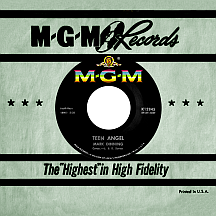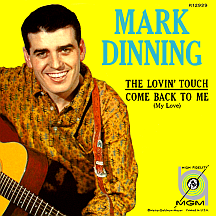MARK DINNING
Teen Angel
"Happy Days?" Not necessarily! This common phrase, often used to describe the era of the 1950s and '60s, lacks the ring of truth if you take into account the peculiar abundancy of "death discs," one of the strangest of all musical trends. These types of tragic narratives were nothing new; the blues of the '20s and '30s frequently wallowed in morbidity, as did the occasional pop or country song (Roy Acuff's 1942 recording of Dorsey Dixon's "Wreck on the Highway," for example, made an unsubtle statement about drinking, driving, blood and prayer). The Grim Reaper's presence was felt from time to time in top sellers of later years ("The Bells," a funereal 1953 hit by The Dominoes, is particularly mournful). Tommy Dee, Carol Kaye and the Teen-Aires' 1959 hit "Three Stars," legendizing the plane crash that took the lives of Ritchie Valens, Buddy Holly and The Big Bopper, was a reaction to a real-life tragedy. In 1960, fictional death songs started coming on strong; Marty Robbins kicked off the decade with "El Paso," a number one hit that kills off the hero at the end. Two weeks later, Johnny Preston topped the chart with "Running Bear," recounting a story about American Indian sweethearts whose love led them to '..that happy hunting ground.' Then Mark Dinning's "Teen Angel" came along, with details just grisly enough to make adolescents wince.
'That fateful night the car was stalled upon the railroad track...I pulled you out and we were safe...but you went running back...' and so the song went, seemingly geared to a younger-than-usual listener, progressing at a morbid level those other recent hits hadn't approached. There was some controversy surrounding the song's message, but it did little to slow momentum; in February, Dinning's "Angel" followed Preston into the number one spot and the "teen tragedy" craze was off and running. Dinning has often been credited with (or blamed for?) inciting others to create their own dead-teen tunes. Dozens of songs plumbed such depths over the next few years, from Ray Peterson's summer '60 racetrack mortality play "Tell Laura I Love Her" to Pat Boone's suicide-by-the-water weeper "Moody River" and The Everly Brothers' air disaster ballad "Ebony Eyes," both in 1961. End-of-life epics were still the rage three years later with lurid car crash smashes "Dead Man's Curve" by Jan and Dean and "Last Kiss" by J. Frank Wilson and the Cavaliers along with a song featuring a fatal finale-on-a-motorcycle, The Shangri-Las' chart-topper "Leader of the Pack." Movies no longer owned the market on gruesome death; the lyrical body count in popular music was rising!
Mark Dinning (birth name Max) couldn't have imagined he would help perpetrate such an outrageous trend that would live on long after rigor-mortis had set in. His original plan was to be a country singer, an outgrowth of the success his three older sisters achieved in the pop field some years earlier. All told, there were nine children in the Dinning family of Nashville by way of rural Oklahoma; Lucille and identical twins Virginia and Eugenia, going by their nicknames Lou, Ginger and Jean, emerged on the Capitol label in 1945 as The Dinning Sisters, backing singer Skip Farrell. Within a year the trio was top-billed on all their 78 RPMs and several releases featuring The Art Van Damme Quintet sold well in '47 and '48; in the latter year they recorded "Buttons and Bows" (originating in the movie The Paleface starring Bob Hope and Jane Russell), which hit the top ten, no mean feat considering a competing version by Dinah Shore was the biggest hit of the entire year. The act had fallen out of favor by the early '50s, partly due to their similarity in style to superstars The Andrews Sisters. Lou made some solo recordings and the group gave it another go on Essex in 1955; Jean also made solo records for that label while Lou remained at Capitol, singing with bandleader and whistler Don Robertson (the two even wrote a song together with Hal Blair, "Not One Minute More," which was a hit for Della Reese just as brother Mark approached the top spot).
MGM signed the younger Dinning to a contract in 1957 and from the start his output was more pop-rock than country; "Shameful Ways," "You Thrill Me" and "Blackeyed Gypsy" are fine efforts among his five singles of '57 and '58. By the time "Cutie, Cutie" was released in the spring of '59 it was clear he was headed in a rock and roll direction, yet his destiny took the form of the tragic ballad his sister Jean composed with help from her husband Red Surrey. The lyrics of "Teen Angel" had an emotional effect on many listeners: 'Just sweet sixteen and now you're gone...they've taken you away...I'll never kiss your lips again...they buried you today.' A million-seller, it was bigger than anything on MGM at the time; even the label's top star, Connie Francis, hadn't yet made it to number one (though she achieved the feat a few months later). Mark's star cooled quickly, but he did have a few follow-ups deserving of more exposure than MGM's promotion department was able to muster.
The less-calamitous "A Star is Born (A Love Has Died)" (also penned by the Surreys) retained the tempo and mood of its predecessor, though the songwriters wisely resisted any temptation to conclude with a corpse lying by the road. The next single, Gerry Goffin and Jack Keller's "The Lovin' Touch," was probably Mark's best shot at another top 40 hit; a midtempo teen rocker with just a hint of suggestiveness, it's more in line with his pre-"Angel" recordings. Yet neither 1960 single rose very high on the charts, nor did "Top Forty, News, Weather and Sports" in early '61, which might qualify for some as a guilty pleasure. A well-produced track with cleverly timely lyrics (by the versatile John D. Loudermilk), the song describes a teenager's likely nightly multitask routine, confusing current events with the relatively recent phenomenon of top 40 radio: 'I had President Ike up at the mic singing Are You Lonesome Tonight' ... 'Khruschev squealin' You Talk-a Too Much' ... 'Rockefella singing a cappella' ... 'and the guys down at Canaveral were shovelin' snow, hollerin' let's go-whoa-whoa-whoa-whoa...' Some terrific material can be found in Mark Dinning's catalog, should one care to dig deeper than "Teen Angel."
Mark's original version of "What Will My Mary Say?," a 1961 B side written by Paul Vance and Eddie Snyder, proved to have hit potential when a cover by Johnny Mathis went top ten in March '63. Several more attempts were made before MGM dropped Dinning after six years on its roster. He had 45s released on Cameo in 1964 and Hickory in '65 and '66, each leaning closer to country, a transition completed with his recordings for United Artists in the late '60s. After that, increased alcohol consumption took its toll as Mark Dinning became less reliable and less able to perform in public. He passed away in 1986 at the age of 52, reuniting with his "Teen Angel" 26 years after-the-fact.



